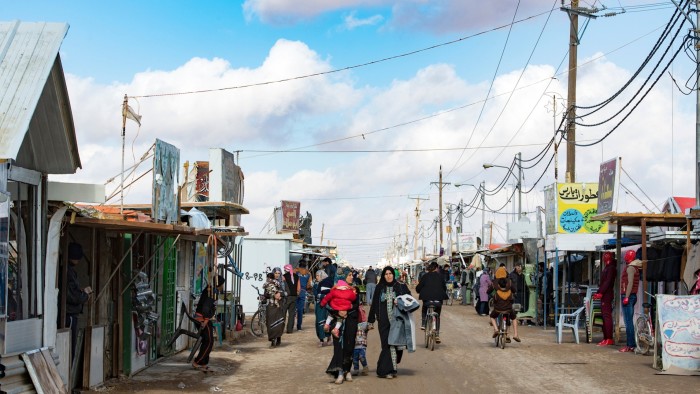In a crisis year for international aid organisations, legal teams are exploring how artificial intelligence could help by cutting costs and workloads.
One organisation hit hard by US President Donald Trump’s clampdown on foreign aid is UNHCR, the UN Refugee Agency. The US formerly provided about $2bn to UNHCR, about a fifth of its budget. The funding block has led to office closures and staff cuts. Yet demand for its help for some of the world’s more than 122mn displaced people is rising.
Lance Bartholomeusz, general counsel at UNHCR, says the challenge of trying to do more with less has led to a sharper focus on AI. “Making generative AI work safely for the people we serve has become an absolute imperative for us this year,” he says.
One example is a digital innovation project piloted by UNHCR in Jordan, to help refugees, mainly Syrians. The agency is using an AI-assisted tool to help respond to their communications and requests. Online or audio queries can be automatically transcribed, translated and organised for assessment. Data is far easier to track, which enables a faster response. So far, it has been tested on 1,000 refugees.
NGOs have used automation and AI for some time, Bartholomeusz says, and he predicts 2025 will be the year of implementation. But moving out of the pilot and experimentation phases brings new challenges, especially around legal data and privacy concerns. This means “legal teams are key”.
Progress has been slow, he admits, but projects such as the Jordan pilot are likely to become operational this year.
Now, as law firms and clients move closer towards putting plans into practice, they are probing operational questions. One finding is that using AI in pro bono work calls for broad expertise. “Especially with generative AI, machine learning and automation projects, volunteers from law firms now bring a broader range of skills . . . beyond traditional legal work,” Bartholomeusz says.
In Hong Kong, Migrasia, an NGO working to eliminate forced labour, has launched a generative AI chatbot, called PoBot. Developed with support from Linklaters Asia, PoBot had engaged with more than 1,800 users by April 2025.
“PoBot is more than just a chatbot,” says Paras Kalura, chief operating officer at Migrasia. “It can quickly triage users’ concerns — whether employer-based, recruiter-based or related to money lenders — and provide relevant advice and legal guidance.” Importantly, he adds: “It’s not designed to replace us but to answer the queries it can.”
Migrasia supports mainly Filipino and Indonesian domestic workers in Hong Kong, but also helps migrants in other jurisdictions, in industries such as manufacturing.
“Compared to running a physical clinic, where two volunteer lawyers might see three clients over three hours, the chatbot drastically reduces response times to the more straightforward queries,” says Kalura. “And, unlike us, it can operate 24/7 and in multiple languages.”
Linklaters provided pro bono legal advice to address intellectual property and privacy risks and offered feedback and user testing. This support was crucial, Kalura notes, in navigating Hong Kong legal questions around large language models.
In Singapore, pro bono lawyers at Baker McKenzie used Microsoft AI chatbot Copilot to search for laws governing children’s rights across many jurisdictions. The verified findings were compiled in a report for international children’s rights network Terre des Hommes (TdH).
Angela Vigil, Baker McKenzie global pro bono partner and executive director, says the task involved handling sensitive information that is also extremely hard to find.
It was worked on in a three-hour “legal sprint” that assembled 30 pro bono lawyers and volunteers. After learning to command Copilot, the team quickly unearthed critical information that would have taken far longer with traditional research methods, says Vigil. This included finding small civil society groups that support children separated from their families in the Philippines and South Korea.
Vigil emphasises that 70 per cent of the sprint workshop time was spent checking the AI findings. “Everything must be rigorously verified by the teams in the room. But using AI cut days or weeks of preliminary work,” she says.
The resulting report is the project’s first step towards creating a global map of organisations that support children’s legal rights, Vigil hopes. “We had tried to start this mapping process multiple times. Copilot really sped up the work,” she says.
In Brisbane, a digital tool developed as part of a pro bono project led by Famin Ahmed at law firm MinterEllison and legal services charity LawRight helps to identify whether vulnerable individuals have been mis-sold loans.
Called Credit Guardian, the AI-powered tool improves with use. For LawRight, the goal is to help people experiencing or at risk of homelessness, since debt can be a big barrier to securing housing. By inputting financial documents, such as bank statements and loan agreements, lawyers can swiftly assess whether a loan complies with Australia’s responsible-lending laws.
Although the system has yet to be fully rolled out, a pilot involving 20 clients indicated that the tool significantly cuts caseloads, especially for people with many loans.
Stephen Grace, director of community and health justice partnerships at LawRight, says the people the organisation advises are at high risk of predatory lending. “Some have dozens of loans — the most we’ve seen is 52 with a single lender,” he says.
While Credit Guardian does not replace pro bono work, it can accelerate and enhance initial legal assessments, he notes.
MinterEllison is refining the tool to ensure data safety and assessment accuracy. Once fully developed, LawRight plans to use it internally, says Grace, who also recognises its potential for broader application.
If 2025 is shaping up to be the year AI in pro bono work moves on from pilots, legal, technological and innovation partnerships will be important to making that happen safely and sustainably.
